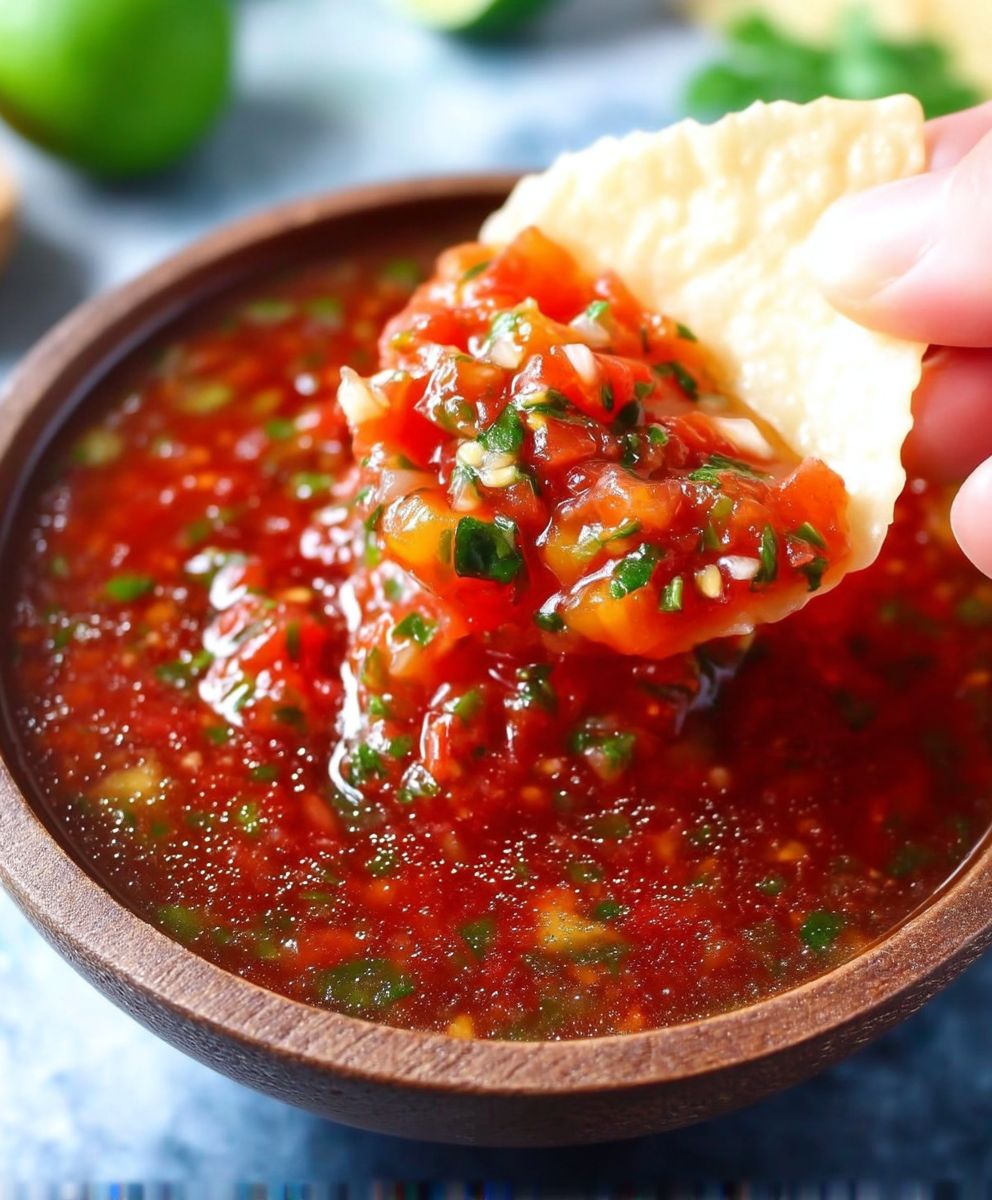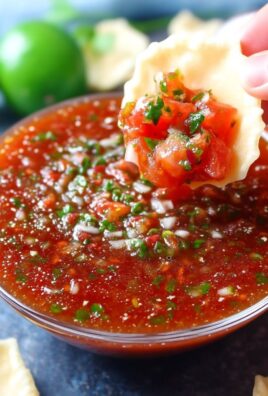Homemade Restaurant Style Salsa: the vibrant, zesty condiment that can elevate any meal from ordinary to extraordinary. Have you ever found yourself craving that perfect salsa from your favorite Mexican restaurant, the one with just the right amount of heat and a chunky, irresistible texture? Well, what if I told you that you could recreate that same magic in your own kitchen, in just minutes?
Salsa, meaning “sauce” in Spanish, has a rich history deeply intertwined with the culinary traditions of Latin America. From its humble beginnings as a simple blend of tomatoes, chilies, and spices, it has evolved into a diverse and beloved staple enjoyed worldwide. The beauty of homemade restaurant style salsa lies in its freshness and the ability to customize it to your exact taste preferences.
People adore this dish for its incredible flavor profile – the bright acidity of tomatoes, the fiery kick of peppers, and the aromatic blend of onions, cilantro, and lime. It’s incredibly versatile, perfect for dipping tortilla chips, topping tacos, or adding a burst of flavor to grilled meats and vegetables. Plus, it’s incredibly quick and easy to make, making it a go-to condiment for busy weeknights or impromptu gatherings. Get ready to ditch the store-bought stuff and experience the unparalleled taste of fresh, homemade salsa!
Ingredients:
- 1 (28 ounce) can whole peeled tomatoes, undrained
- 1 (10 ounce) can diced tomatoes and green chilies, undrained (like Rotel)
- 1/2 medium white onion, roughly chopped
- 2-3 cloves garlic, minced
- 1-2 jalapeños, seeded and roughly chopped (adjust to your spice preference)
- 1/4 cup chopped fresh cilantro
- 1 tablespoon lime juice, freshly squeezed
- 1 teaspoon ground cumin
- 1/2 teaspoon sugar
- 1/4 teaspoon salt (or to taste)
- Pinch of cayenne pepper (optional, for extra heat)
Preparing the Salsa:
- Prepare the Tomatoes: Open the can of whole peeled tomatoes. I like to gently squeeze each tomato with my hands to break them up a bit before adding them to the blender or food processor. This helps achieve a smoother consistency. Don’t drain the tomatoes; the juice is essential for the right texture.
- Combine Initial Ingredients: Add the squeezed whole peeled tomatoes (with their juice) and the can of diced tomatoes and green chilies (undrained) to your blender or food processor.
- Add Aromatics and Spices: Now, add the roughly chopped white onion, minced garlic, seeded and chopped jalapeños, cilantro, lime juice, cumin, sugar, salt, and cayenne pepper (if using) to the blender or food processor.
- Pulse to Desired Consistency: This is where you control the texture of your salsa. I prefer a slightly chunky salsa, so I pulse the mixture in short bursts. Start with about 5-6 pulses, checking the consistency after each pulse. If you prefer a smoother salsa, pulse for a longer duration, but be careful not to over-process it into a puree. Remember, you can always pulse more, but you can’t un-pulse!
- Taste and Adjust Seasoning: This is the most important step! Pour the salsa into a bowl and taste it. Does it need more salt? Add a pinch at a time, stirring well and tasting after each addition. Is it not spicy enough? Add a pinch of cayenne pepper or a few drops of hot sauce. Is it too acidic? Add a tiny bit more sugar to balance the flavors. Don’t be afraid to experiment and adjust the seasoning to your liking. The beauty of homemade salsa is that you can customize it to your exact preferences.
- Chill for Optimal Flavor: Cover the bowl of salsa with plastic wrap or transfer it to an airtight container. Refrigerate for at least 30 minutes, or preferably an hour or two, before serving. Chilling allows the flavors to meld together and intensifies the taste. I find that the salsa tastes even better the next day!
Tips and Tricks for the Best Salsa:
- Tomato Quality Matters: The quality of your canned tomatoes will significantly impact the flavor of your salsa. I recommend using a good quality brand of whole peeled tomatoes for the best results. San Marzano tomatoes are a great choice if you can find them.
- Spice Level Control: The amount of jalapeño you use will determine the spiciness of your salsa. For a mild salsa, use only one jalapeño and remove all the seeds and membranes. For a medium salsa, use two jalapeños and remove most of the seeds and membranes. For a spicy salsa, use two or three jalapeños and leave some of the seeds and membranes intact. Remember to wash your hands thoroughly after handling jalapeños!
- Fresh is Best (Especially Lime Juice): While bottled lime juice can work in a pinch, freshly squeezed lime juice will always provide a brighter and more vibrant flavor. It really makes a difference!
- Don’t Over-Process: Over-processing the salsa will result in a watery and less flavorful salsa. Pulse the ingredients until they are coarsely chopped, but still retain some texture.
- Cilantro Considerations: Some people love cilantro, while others have a genetic aversion to it and find that it tastes like soap. If you are not a fan of cilantro, you can omit it altogether or substitute it with a different herb, such as parsley.
- Roasting for Depth of Flavor: For an even deeper and more complex flavor, you can roast the tomatoes, onion, garlic, and jalapeños before blending them. To roast, preheat your oven to 400°F (200°C). Toss the tomatoes, onion, garlic, and jalapeños with a little olive oil and spread them on a baking sheet. Roast for 20-25 minutes, or until the vegetables are softened and slightly charred. Let them cool slightly before adding them to the blender or food processor.
- Using a Food Processor vs. Blender: Both a food processor and a blender can be used to make salsa. A food processor will generally give you a chunkier salsa, while a blender will produce a smoother salsa. If you are using a blender, be careful not to over-process the salsa, as it can easily become a puree.
- Storage: Homemade salsa will keep in the refrigerator for up to 5 days in an airtight container. The flavor may intensify over time.
- Serving Suggestions: This homemade salsa is delicious served with tortilla chips, tacos, burritos, quesadillas, nachos, or as a topping for grilled chicken or fish. It’s also a great addition to scrambled eggs or omelets.
- Freezing Salsa: You can freeze homemade salsa for longer storage. Transfer the salsa to an airtight container or freezer bag, leaving some headspace for expansion. Freeze for up to 3 months. Thaw the salsa in the refrigerator overnight before serving. The texture may change slightly after freezing, but the flavor will still be delicious.
Variations and Additions:
- Mango Salsa: Add 1/2 cup of diced mango to the salsa for a sweet and fruity twist.
- Pineapple Salsa: Add 1/2 cup of diced pineapple to the salsa for a tropical flavor.
- Black Bean and Corn Salsa: Add 1/2 cup of cooked black beans and 1/2 cup of corn kernels to the salsa for a heartier and more filling salsa.
- Avocado Salsa: Add 1 diced avocado to the salsa just before serving for a creamy and rich salsa. Be aware that the avocado will brown quickly, so it’s best to add it right before serving.
- Smoked Paprika: Add a pinch of smoked paprika for a smoky flavor.
- Chipotle Peppers in Adobo Sauce: Add 1-2 chipotle peppers in adobo sauce for a smoky and spicy flavor. Be sure to remove the seeds and membranes from the chipotle peppers before adding them to the salsa.
- Different Types of Tomatoes: Experiment with different types of canned tomatoes, such as fire-roasted tomatoes or crushed tomatoes, to change the flavor and texture of the salsa.
- Roasted Garlic: Use roasted garlic instead of raw garlic for a sweeter and milder garlic flavor.
- Different Types of Onions: Try using red onion or yellow onion instead of white onion for a different flavor profile.
Enjoy your delicious homemade restaurant-style salsa! I hope you find this recipe helpful and that you enjoy making and eating it as much as I do. Don’t be afraid to experiment and customize the recipe to your own taste preferences. Happy salsa making!

Conclusion:
So there you have it! This Homemade Restaurant Style Salsa recipe isn’t just another salsa recipe; it’s a ticket to flavor town, a vibrant explosion of fresh ingredients that will elevate your snacking game to a whole new level. I truly believe that once you taste the difference between store-bought and this homemade version, you’ll never go back. The bright, tangy, and slightly spicy profile is simply irresistible, and the satisfaction of knowing you created something so delicious from scratch is incredibly rewarding.
Why is this a must-try? Well, beyond the incredible taste, it’s incredibly versatile. Think beyond just tortilla chips! This salsa is fantastic on grilled chicken or fish, adding a zesty kick to your tacos or burritos, or even as a flavorful topping for scrambled eggs in the morning. It’s a healthy and delicious way to add some zing to just about any meal.
And speaking of versatility, let’s talk about variations! Feel free to adjust the heat level to your liking. If you prefer a milder salsa, reduce the amount of jalapeño or remove the seeds and membranes altogether. For those who like it extra spicy, add a serrano pepper or a pinch of cayenne pepper. You can also experiment with different types of tomatoes. Roma tomatoes are a classic choice, but you could also use heirloom tomatoes for a richer, more complex flavor.
Another fun variation is to add a touch of sweetness. A small squeeze of honey or a pinch of sugar can balance out the acidity of the tomatoes and create a more well-rounded flavor profile. You could also try adding a roasted corn for a smoky and sweet twist. If you’re feeling adventurous, consider adding a fruit element like mango or pineapple for a tropical salsa that’s perfect for summer barbecues.
Serving suggestions are endless! Of course, it’s amazing with tortilla chips, but don’t stop there. Try it with plantain chips, pita bread, or even as a dip for raw vegetables. It’s also a fantastic addition to a cheese board, adding a pop of color and flavor. I personally love to use it as a marinade for chicken or fish before grilling. The acidity helps to tenderize the meat and the flavors infuse beautifully.
This Homemade Restaurant Style Salsa is more than just a recipe; it’s an experience. It’s about taking the time to create something special, something that you can share with your friends and family. It’s about enjoying the simple pleasures of life, like the taste of fresh, vibrant ingredients.
I truly hope you’ll give this recipe a try. I’m confident that you’ll love it as much as I do. And when you do, please, please, please share your experience! Let me know what variations you tried, what you served it with, and what your friends and family thought. I’m always eager to hear your feedback and learn from your experiences. You can leave a comment below, tag me on social media, or even send me an email. I can’t wait to hear from you! Happy salsa-making!
Homemade Restaurant Style Salsa: The Ultimate Recipe Guide
Quick and easy homemade salsa that tastes just like your favorite restaurant's! Made with fresh ingredients and customizable to your spice preference.
Ingredients
Instructions
Recipe Notes
- Tomato Quality Matters: Use a good quality brand of whole peeled tomatoes for the best results.
- Spice Level Control: Adjust the amount of jalapeño to your spice preference. Remove seeds and membranes for a milder salsa.
- Fresh is Best (Especially Lime Juice): Freshly squeezed lime juice will always provide a brighter and more vibrant flavor.
- Don’t Over-Process: Over-processing the salsa will result in a watery and less flavorful salsa.
- Cilantro Considerations: If you are not a fan of cilantro, you can omit it altogether or substitute it with a different herb, such as parsley.
- Roasting for Depth of Flavor: For an even deeper and more complex flavor, you can roast the tomatoes, onion, garlic, and jalapeños before blending them.
- Using a Food Processor vs. Blender: A food processor will generally give you a chunkier salsa, while a blender will produce a smoother salsa.
- Storage: Homemade salsa will keep in the refrigerator for up to 5 days in an airtight container.
- Serving Suggestions: This homemade salsa is delicious served with tortilla chips, tacos, burritos, quesadillas, nachos, or as a topping for grilled chicken or fish.
- Freezing Salsa: You can freeze homemade salsa for longer storage.





Leave a Comment